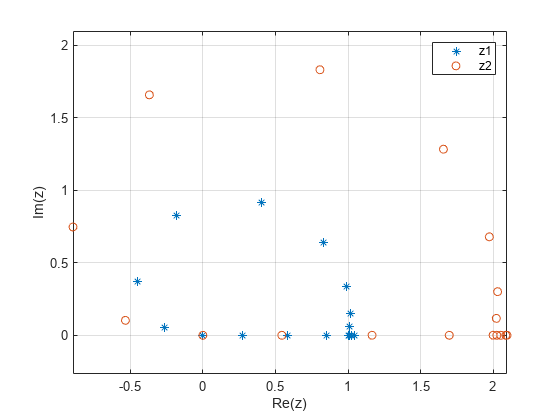绘制复数
此示例说明如何在 MATLAB® 中绘制复数。复数 是可以写为以下形式的数字
,
其中 和 是实数, 是虚数单位,定义为 。数字 是复数的实部,由 表示,数字 是复数的虚部,由 表示。您可以将复数绘制为复平面上的一对坐标 ,亦称阿根图。此图使用笛卡尔坐标表示 轴上的实部和 轴上的虚部。
您也可以使用极坐标来表示复数。复数写为以下形式
,
其中 是复数的绝对值或模, 是复数的相位角。在此表示中,您可以将复数绘制为极坐标中的点,半径为 (与原点的距离),极坐标角为 (正实轴与该点到原点的连线之间的逆时针夹角)。
绘制复数数组
创建一个包含复数 3 + 4i、-4 - 3i、1 - 2i 和 -1 - 1i 的向量。
z = [3 + 4i; -4 - 3i; 1 - 2i; -1 - 1i]
z = 4×1 complex
3.0000 + 4.0000i
-4.0000 - 3.0000i
1.0000 - 2.0000i
-1.0000 - 1.0000i
使用 plot 绘制复数向量 z 的虚部对实部的图。使用 real 函数和 imag 函数分别返回复数向量的实部和虚部。
plot(real(z),imag(z),"o") axis equal grid on xlabel("Re(z)") ylabel("Im(z)")
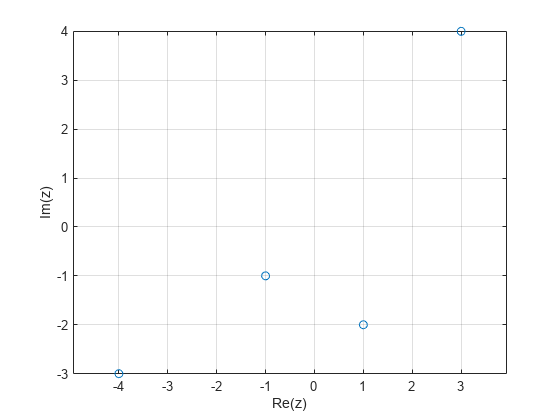
您还可以使用 plot(z,LineSpec) 而不是 plot(real(z),imag(z),LineSpec) 来绘制复数数组。此函数自动绘制 轴上的实部和 轴上的虚部。
在笛卡尔坐标中绘制复单位根
单位的 次根是满足多项式方程的复数
,
其中 是正整数。
单位的 次根是
,。
要求出单位的复根,可以使用 roots 求解多项式方程。roots 函数对 格式的多项式方程求解。例如,求 或 的 5 次单位根。
p = [1 0 0 0 0 -1]; z = roots(p)
z = 5×1 complex
-0.8090 + 0.5878i
-0.8090 - 0.5878i
0.3090 + 0.9511i
0.3090 - 0.9511i
1.0000 + 0.0000i
在笛卡尔坐标中绘制复单位根。
plot(z,"o") axis equal grid on xlabel("Re(z)") ylabel("Im(z)")

在极坐标中绘制复数
使用 polarplot 在极坐标中绘制 5 次单位根。使用 angle 函数返回复根的相位角,使用 abs 函数返回复根的绝对值或半径。
polarplot(angle(z),abs(z),"o")
您还可以使用 polarplot(z,LineSpec) 而不是 polarplot(angle(z),abs(z),LineSpec) 来绘制极坐标中的复数数组。此函数自动绘制复数的半径和相位角。
在复平面中绘制参数化曲线
定义以下形式的参数化曲线
其中,参数 在区间 中。
在此区间内创建一个包含 200 个等间距点的向量 t 以参数化 。将位于复曲线上的点定义为复数向量 z。
t = linspace(0,4*pi,200); z = t.*exp(1i*t);
在笛卡尔坐标中绘制复曲线。
plot(z,"-") axis equal grid on xlabel("Re(z)") ylabel("Im(z)")
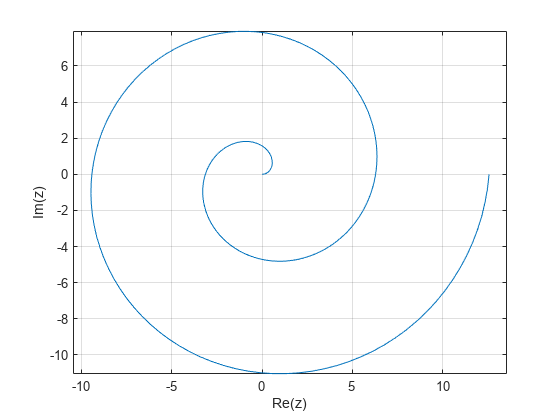
在极坐标中绘制复曲线。
polarplot(z,"-")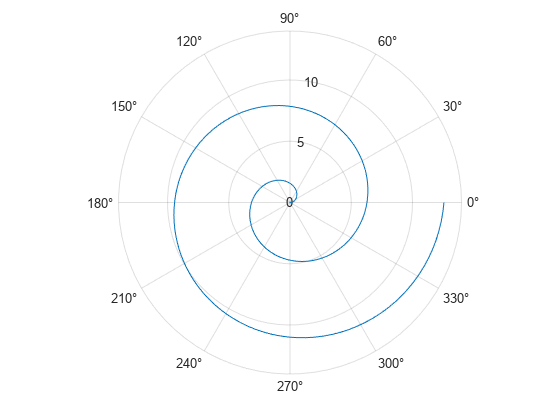
绘制方阵的特征值
一个 × 实数方阵有 个特征值(包括代数重数),这些特征值或者是实数,或者出现在复共轭对组中。
例如,假设有一个 20×20 实矩阵,其随机元素是从标准正态分布中采样的。使用 eig 计算特征值。
rng("default")
z = eig(randn(20));绘制所有 20 个特征值的虚部对实部的图。请注意,对于不在实轴上的每个特征值 ,此特征值还有另一个复共轭对组 。
plot(z,"o") axis equal grid on xlabel("Re(z)") ylabel("Im(z)")
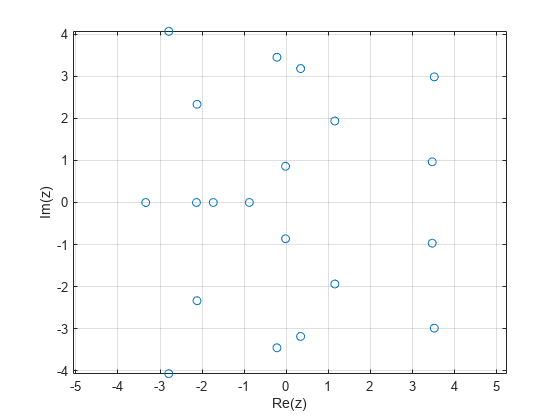
绘制多个复数数据集
绘制两个复数数据集的虚部对实部的图。如果您将多个复数输入参量传递给 plot,例如 plot(z1,z2),则 plot 函数将忽略输入的虚部,而仅绘制实部。要为多个复数输入绘制多个实部对虚部的图,必须将实部和虚部显式传递给 plot。
例如,创建两个复数向量 z1 和 z2。
x = -2:0.25:2; z1 = x.^exp(-x.^2); z2 = 2*x.^exp(-x.^2);
通过使用 real 和 imag 函数求出每个向量的实部和虚部。
re_z1 = real(z1); im_z1 = imag(z1); re_z2 = real(z2); im_z2 = imag(z2);
绘制复数数据。
plot(re_z1,im_z1,"*",re_z2,im_z2,"o") axis equal grid on legend("z1","z2") xlabel("Re(z)") ylabel("Im(z)")
